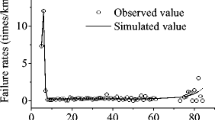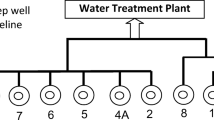Abstract
This paper provides a method for evaluating the residual lives of water pipes using the proportional hazards model (PHM) based on the economically optimal replacement times of pipes. The survival times, which are used in the proportional hazards modeling process, were defined as the economically optimal replacement times of pipes. The break rate of an individual pipe is estimated using the General Pipe Break Model (GPBM). The optimal replacement time of a pipe is obtained using the equivalence relationship between the GPBM and threshold break rate. In order to use the GPBM effectively, the process of estimating the GPBM has been modified in this paper by utilizing additional break data for the time of installation and adjusting the value of the weighting factor (WF) in the GPBM. The residual lives and hazard ratios of the case study pipes, of which the cumulative number of breaks was at least one, were estimated using the estimated survivor function of the constructed PHM. The time-dependency of the pipe material covariate caused the hazard rate of the cast iron pipes to become lower than the hazard rate of the steel pipes after 19 years since installation. The methodology developed in this paper may help utilities identify important factors related to the economics of water pipe maintenance and; therefore more efficiently maintain their water pipes.
Similar content being viewed by others
References
Allison PD (1995) Survival analysis using SAS: a practical guide. SAS Institute, USA
American Water Works Association (AWWA) (2001) Dawn of the replacement era: reinvesting in drinking water infrastructure. American Water Works Association, USA
Andreou SA, Marks DH, Clark RM (1987a) A new methodology for modeling break failure patterns in deteriorating water distribution systems: applications. Adv Water Resour 10:2–10
Andreou SA, Marks DH, Clark RM (1987b) A new methodology for modeling break failure patterns in deteriorating water distribution systems: applications. Adv Water Resour 10:11–20
Brémond B (1997) Statistical modeling as help in network renewal decision. European commission co-operation on science and technology (COST). Committee C3-Diagnostics of Urban Infrastructure, Paris
Christodoulou S, Deligianni A (2010) A neurofuzzy decision framework for the management of water distribution networks. Water Resour Manage 24:139–156
Collet D (2003) Modelling survival data in medical research. Chapman & Hall, Boca Raton, pp 80–87
Conner RC (1999) Pipeline safety, reliability, and rehabilitation. American Society of Civil Engineers, USA, pp 353–381
Cox DR (1972) Regression models and life tables. J R Stat Soc 34(2):187–220
Davis R (2007) The case of San Diego’s vanishing water. E-mainstream. http://www.awwa.org/publications/MainStreamArticle.cfm?itemnumber=29525. Accessed 26 Aug 2009
Eisenbeis P (1994) Modélisation statistique de la prévision des défailances sur les conduites d’eau potable. PhD thesis, University Louis Pasteur of Strasbourg, collection Etudes Cemagref No 17
Environmental Protection Agency (EPA) (2001) Drinking water infrastructure needs survey: second report to congress. Environmental Protection Agency, USA, p 19
Kleiner Y, Adams BJ, Rogers JS (1998) Long-term planning methodology for water distribution system rehabilitation. Water Resour Res 34(8):2039–2051
Klein JP, Moeschberger ML (2003) Survival analysis: techniques for censored and truncated data. Springer, New York, pp 374–379
Kleiner Y, Rajani BB (2001) Comprehensive review of structural deterioration of water mains: statistical models. Urban Water 3(3):157–176
Knaus W, Weizsacker E (2007) Vergleich Europäischer Wasser- und Abwasserpreise - VEWA. GWFWasser Abwasser 148(7/8):530–534
Lei J (1997) Statistical approach for describing lifetimes of water mains—case Trondheim municipality. Report no 22F007.28, SINTEF Civil and Environmental Engineering, Trondheim
Li D, Haims YY (1992a) Optimal maintenance-related decision making for deteriorating water distribution systems 1. Semi-Markovian model for a water main. Water Resour Res 28(4):1053–1061
Li D, Haims YY (1992b) Optimal maintenance-related decision making for deteriorating water distribution systems 2. Multilevel decomposition approach. Water Resour Res 28(4):1063–1070
Loganathan GV, Park S, Sherali HD (2002) Threshold break rate for pipeline replacement in water distribution systems. J Water Resour Plan Manage ASCE 128(4):271–279
Marks HD, Andreou S, Jeffrey L, Park C, Zaslavski A (1987) Statistical models for water main failures. US Environmental Protection Agency (Co-operative Agreement CR8 1 0558) M I T Office of Sponsored Projects, No 94211, Boston, MA
Milner M (2006) Thames Water fails to plug leaks but profits rise 31%. The guardian. http://www.guardian.co.uk/environment/2006/jun/21/water.business. Accessed 26 Aug 2009
Park S, Loganathan GV (2002) Optimal pipe replacement analysis with a new pipe break prediction model. J Korean Soc Water Wastewater 16(6):710–716
Park S, Kim JW, Newland A, Kim BJ, Jun HD (2008) Survival analysis of water distribution pipe failure data using the proportional hazards model. World Environmental and Water Resources Congress 2008: Ahupua’a. Proc World Environmental Water Resources Congress 2008, vol 40, no 6, pp 495–502
The Irish Times (2008) €118m Dublin water pipe relaying begins. http://www.rte.ie/news/2008/0407/water.html. Accessed 26 Aug 2009
Therneau TM, Grambsch PM, Fleming TR (1990) Martingale-based residuals for survival models. Biometrika 77(1):147–160
Wild D, Francke CJ, Menzli P, Schon U (2007) SAM Study < <water: a market of the future> >. Sustainable Asset Management (SAM), Switzerland
Author information
Authors and Affiliations
Corresponding author
Rights and permissions
About this article
Cite this article
Park, S., Choi, C.L., Kim, J.H. et al. Evaluating the Economic Residual Life of Water Pipes Using the Proportional Hazards Model. Water Resour Manage 24, 3195–3217 (2010). https://doi.org/10.1007/s11269-010-9602-3
Received:
Accepted:
Published:
Issue Date:
DOI: https://doi.org/10.1007/s11269-010-9602-3




